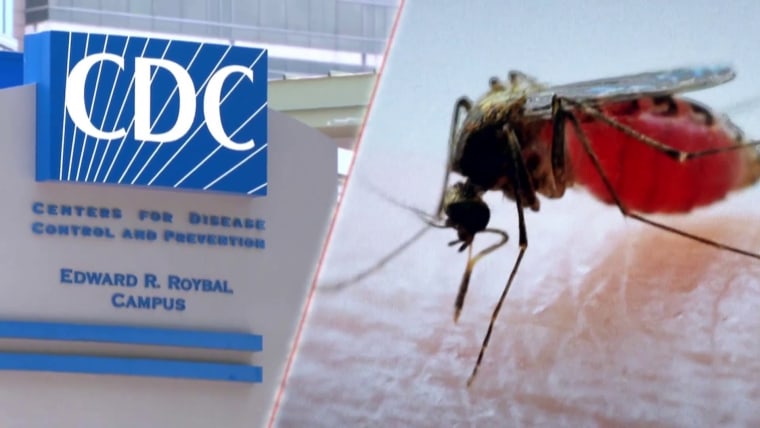Summer is peak tick and mosquito season, and the insects may pose a particularly acute threat this year, experts say. On Monday, the Centers for Disease Control and Prevention issued an alert about the first locally acquired cases of malaria in the United States in 20 years, detected in Florida and Texas.
Mosquitoes thrive in hot, humid conditions, so the season’s high temperatures aren’t helping: Blistering heat is blanketing Texas, with heat warnings and advisories in effect for a dozen states. A report published last month from the research organization Climate Central found that the number of annual “mosquito days” — defined as days with an average relative humidity of 42% or higher and temperatures of 50 to 95 degrees Fahrenheit — have increased since 1979 in more than 70% of the U.S. locations studied.
“A lot of work in the 20th century went into eradicating malaria from the U.S., involving a lot of things that might not have been environmentally friendly,” said Dr. Ryan Miller, an infectious disease specialist at the Cleveland Clinic. “But having it reintroduced into the U.S. kind of raises a red flag.”
The risk of contracting malaria in the U.S. remains low. But mosquitoes can also transmit West Nile virus, which can cause fever, headache, body pains, vomiting, diarrhea or rash — though 8 out of 10 people who contract it don’t develop symptoms, according to the CDC. The agency recorded more than 1,100 cases last year, though case numbers have remained close to 2,000 annually for the last decade.
Tick season, meanwhile, is typically worst from late May to early July. Experts say they have observed tick populations expanding beyond rural areas and into cities over the last several years.
The CDC estimates about 476,000 people per year contract Lyme disease — the most prevalent threat from ticks. But other less common tick-borne diseases, including babesiosis and Rocky Mountain Spotted Fever, have seen U.S. case numbers climb in the last decade.
Miller said that as temperatures rise because of climate change, threats from ticks and mosquitoes are becoming less seasonal.
“Unfortunately, having a rather warm and mild winter, the tick and mosquito seasons have already been here,” Miller said. “We have had cases of Lyme disease even in the spring, which is a little more unusual, and a few people even in late fall last year. It’s looking like this year, it’s going to be all year-round.”
Tracking mosquito-borne diseases across the U.S.
The CDC had recorded 385 cases of dengue, another mosquito-borne illness, in the U.S. as of June 1. More than 250 of those infections were in Puerto Rico; in an article last month, the agency urged more action to control dengue’s spread in U.S. territories.
As of Tuesday, the CDC had confirmed 17 cases of West Nile virus, seven of which were in Arizona. The most high-risk months for the virus are still ahead, according to Graham McKeen, assistant university director of public and environmental health at Indiana University.
McKeen said the Aedes aegypti mosquito, which carries the dengue and Zika viruses, has become increasingly common in the South and Southwest over the last decade.
“We’re seeing them in new areas where they weren’t found before,” he said. “Our kind of extensive use of pesticides over many decades has led to some increased pesticide resistance in mosquitoes as well.”
McKeen added that people can still take “tried-and-true” precautions like wearing bug spray and long-sleeved clothes and pants.
“Try to eliminate any standing or stagnant water in or around your property,” he said.
A mild winter may mean more ticks
This year’s mild winter has led to more cases of tick-borne infections than usual, particularly Lyme disease, according to Maria Diuk-Wasser, a vector-borne disease specialist and professor at Columbia University.
“The increasing cases are usually in new regions that didn’t have it before, so we see in Maine, Ohio and Michigan, a lot of Northern states, it’s increasing a lot,” Diuk-Wasser said. “We are all reporting a very high year.”
Adult ticks are most active in the spring, but teenage ticks in the summertime are more dangerous, Diuk-Wasser added, because these nymphal ticks are roughly the size of a poppy seed. That makes them hard to spot even after they bite.
For protection, she recommended immediately washing clothing or at least running items in the dryer after spending time outdoors. People should also continue checking themselves for ticks on subsequent days, since a nymphal tick can grow and become more easily spotted.
Ticks may be encroaching into cities like Austin, Texas, Chicago, New York and Pittsburgh, Diuk-Wasser added. Her lab has been studying how migrating deer — known tick hosts — have been introducing the bugs into parts of New York City, particularly parks and outdoor areas in Queens.
In collaboration with several other universities, Diuk-Wasser’s lab helps run The Tick App, a tool that enables users to send in a picture of the tick that bit them for further information — including whether it is the Lyme-disease-carrying blacklegged tick.
“We still need to enjoy the outdoors and really preserve all the green spaces we have in the cities, so we should not be scared of ticks,” Diuk-Wasser said. “We just need to protect ourselves and be aware.”







